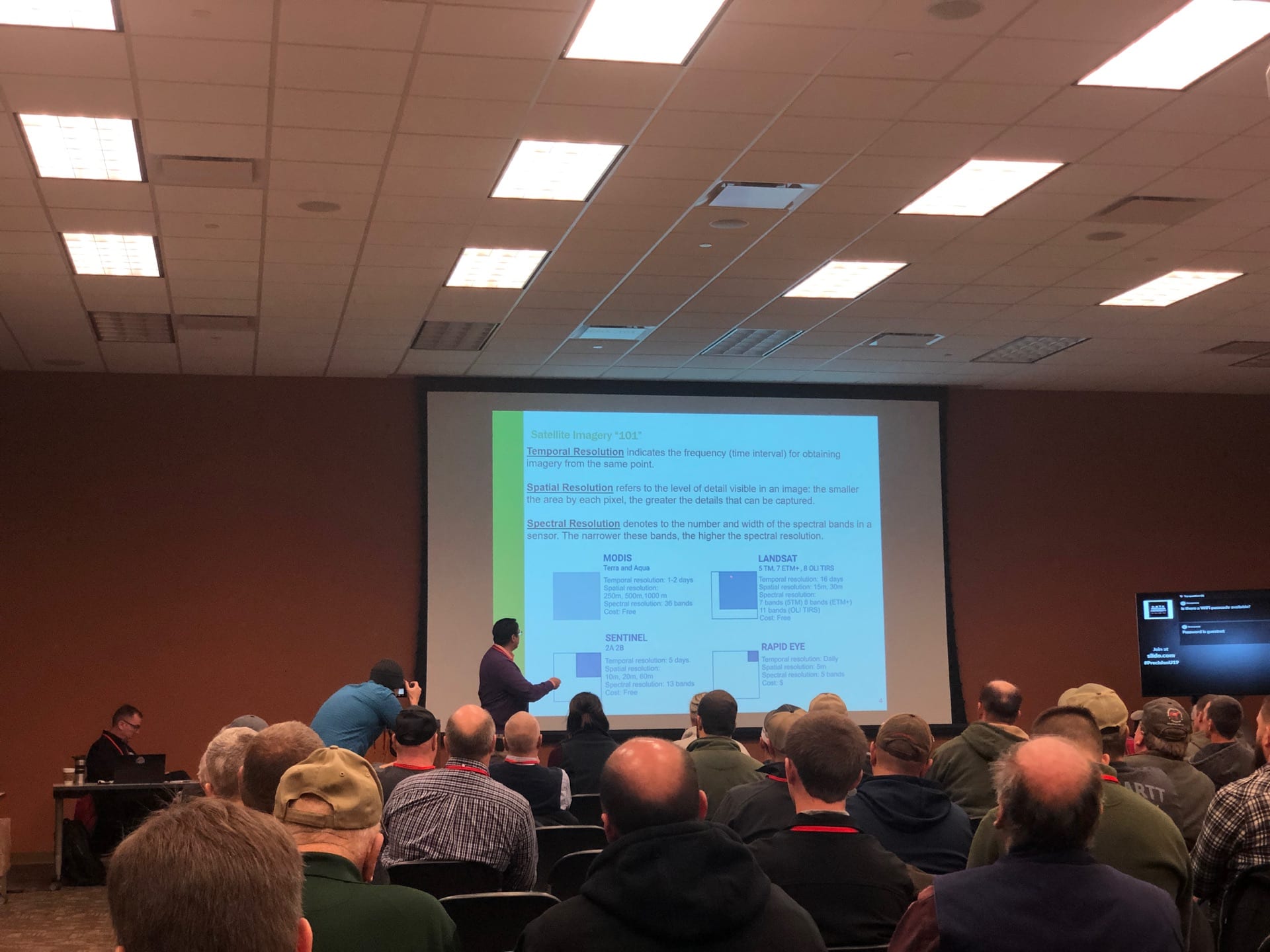Brooke Beam, Ph.D.
Ohio State University Extension, Highland County
Agriculture and Natural Resources/Community Development Extension Educator
January 9, 2019

Dr. Ignacio Ciampitti, of the University of Nebraska, spoke at the Ohio State University Extension 2019 Precision University on Satellite Data and Agronomic Decisions.
As I write this column, the snow is falling outside. It is hard to believe that spring is right around the corner, but preparation for the 2019 crop season is in full swing. On Wednesday, January 9, 2019, I attended Ohio State University Extension’s Precision University: In-Season Decisions, at Beck’s Seed in London, Ohio. This program provided attendees with information about the latest technologies to incorporate into their farming operations in order to maximize efficiency and yields.
One tool to consider for the upcoming growing season is satellite imagery. Dr. Ignacio Ciampitti, from Kansas State University, spoke on the benefits of using satellite imagery for evaluating fields. Dr. Ciampitti said that satellites are not a replacement for drones (UAVs), but they do offer a wide variety of benefits. Due to the number of satellites, there are a variety of resolutions of images farmers can obtain of their fields to evaluate their farm management decisions. Some examples of satellites that generate these images include Modis, Landsat, Sentinel, and Rapid Eye. The Sentinel satellite currently provides the highest resolution for agricultural purposes.
Satellites offer the ability to “go back in time” with databases of images compiled over the course of years, stated Dr. Ciampitti. Drones provide an image of the current situation, which for some field scouting situations is appropriate; however, in some cases, it may be better to study the field over time. Uses of satellite imagery for the agricultural industry include seasonal and temporal (across seasons) monitoring of crops, crop scouting, forecasting yields, site-specific management, and environmental factors, such as insects, said Dr. Ciampitti.
While we wait on spring, farmers can evaluate previous satellite images of their fields to identify areas of their fields that may need a special prescription. During the growing season, comparing satellite imagery from the mid-flowering stages to your yield monitor images will also provide analysis for future yield predictions.
Several satellite images are available for free, depending on what information you need to obtain from the image. For more information about technologies and information from the 2019 Precision University, contact the Highland County Extension Office at 937-393-1918.
Upcoming Events:
The next Beef Quality Assurance Training will be held at Union Stockyards on Tuesday, January 22, 2018, at 6:30 P.M. A meal will be served at 5:30 P.M. prior to the class. Please RSVP to the Highland County Extension Office at 937-393-1918.
Another Beef Quality Assurance Training will be held at United Producers Inc., at 2 P.M. on January 29, 2019. There will not be a meal included at this training. Please RSVP to the Highland County Extension Office at 927-393-1918.
The next Highland County Master Gardener Volunteer meeting will be held on Thursday, January 17, 2019, at 10 AM in the Large Meeting Room in the basement of 110 Governor Foraker Place, Hillsboro, OH.
On Tuesday, February 5, 2019, a live webinar of the 2019 Ohio Beef Cattle School will be held in the Large Meeting Room of 119 Governor Foraker Place, Hillsboro, OH. The program will begin at 7 P.M. The 2019 Ohio Beef Cattle School is free to attend, but RSVPs are required. The topic of the webinar is on the winter management of the cow herd to ensure a productive 2019. RSVP to the Highland County Extension Office at 937-393-1918 or via email to beam.49@osu.edu.
Fertilizer and Pesticide Recertifications:
February 19, 2019
Ponderosa Banquet Center, 545 S. High Street, Hillsboro, Ohio 45133
5:00 pm to 6:00 pm Fertilizer Recertification – Private and Commercial
6:30 pm Pesticide Recertification (Core, 1, 2,3, 4, 5, 6) Private Applicators Only
March 4, 2018
Ponderosa Banquet Center, 545 S. High Street, Hillsboro, Ohio 45133
10:00 am to 11:00 am Fertilizer Recertification – Private and Commercial
11:30 am Pesticide Recertification (Core, 1, 2,3, 4, 5, 6) Private Applicators Only
Registration details will come in the mail from the Ohio Department of Agriculture. Registration for OSU Extension Pesticide and Fertilizer and your renewal application for ODA Pesticide/Fertilizer must both be completed. Meals will be included at each recertification training at Ponderosa.
